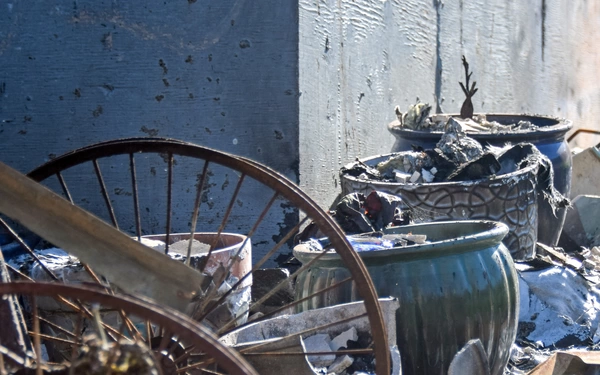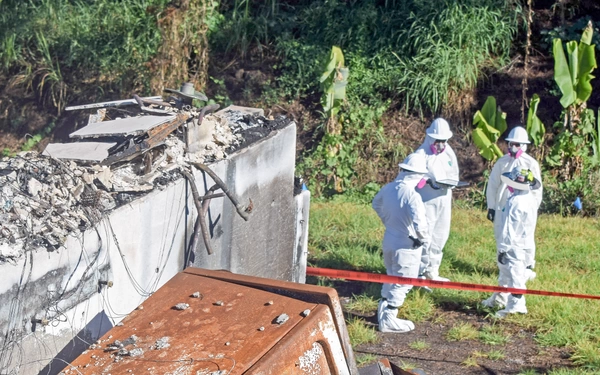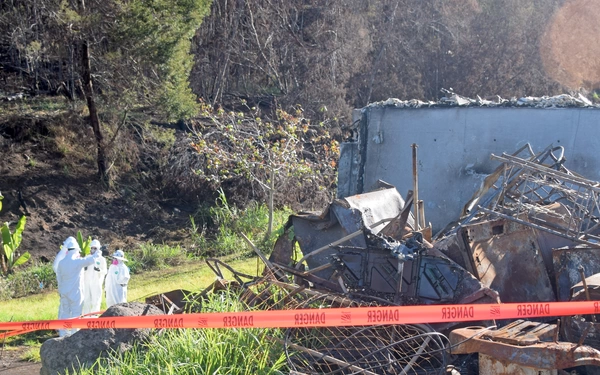Contractor with US Army Corps of Engineers begins hazardous fire site assessments in Kula
On Saturday, Phase 1 of the US Army Corps of Engineers-led removal of private property debris began with hazardous site assessments for 26 properties in Kula that were burned by the Aug. 8 wildfire.
The Army Corps awarded a $52.5 million contract to Honolulu-based Dawson Solutions, a Native Hawaiian Organization that has worked for other federal government clients, to do the work in Phase 1 for Kula/Olinda and Lahaina burned properties.
For the first phase, three crews will conduct the site assessments, which will take about a 1/2 day per property.
“They come through with iPads and note everything that is on the property, inspecting hazardous materials and anything that needs to be removed or anything that could be a safety concern to any of the crews,” said Brian Brandt, resident engineer for the debris planning and response team, in a video.
During this phase, crews also will “non-intrusively” remove by hand some household hazardous material — “basically anything under your kitchen sink” — and bulk asbestos material, like large floor or ceiling tiles,” said Mark Cardwell, Emergency Management Specialist with the Army Corps, during a media call.
The US Environmental Protection Agency previously completed this type of removal of hazardous household material and large asbestos.
But Cardwell said the EPA did more of a “quick through” while the current phase is more “deliberate” with the entire property assessed.
A Native Hawaiian cultural team also goes through the properties to identify anything that is culturally sensitive so other crews can work around it or do further inspections, Brandt said.
Phase 2 debris removal starts after the site assessments come back. The assessments include taking tests and samples for asbestos and other hazardous materials. Results of these tests and samples takes about five days, Brandt said.
The final assessment reports are turned over to the phase 2 contractor that does the removal.
“So about two weeks after this we expect to getting into actual [debris] removal,” Brandt said.
Cardwell said the assessments provide a “roadmap or site diagram” about how the debris will be removed from each property.
Once the Phase 2 process begins to remove debris, it will take an average of about 2 1/2 to 3 days per property. Some properties will take longer due to rugged terrain or the need for further remediation, with at least one property that has an electric car in which the battery will need to be removed.
A road may even need to be built to access some properties along a gulch, Cardwell said.
While signed “right of entry” forms from property owners are not needed for Phase 1 due to public safety, they are required for Phase 2. The Army Corps said they have received permission to do the debris removal from 26 of the approximately 30 property owners affected by the Upcountry fires.
The Federal Emergency Management Agency is expected to fund 100% of the debris removal for Kula.
This is about the 20th time the Army Corps of Engineers has conducted this type of debris removal, Cardwell said.
“The goal is to have operations complete within 30 days,” Cardwell said.
The process to remove debris from the much larger Lahaina burn area of about five-square-miles will be similar. Lahaina is further behind in the process due to the large area and the longer search process for human remains.
The “science nature” of fires also makes debris removal a slower process that other types of disaster like hurricanes. Cardwell said the burned material goes through some different processes, including turning into ash that has the ability to be airborne with toxic materials.
For information on the U.S. Army Corps of Engineers Hawai‘i wildfire response, visit https://www.poh.usace.army.mil/Missions/Emergency-Response/Hawaii-Wildfires/.



















